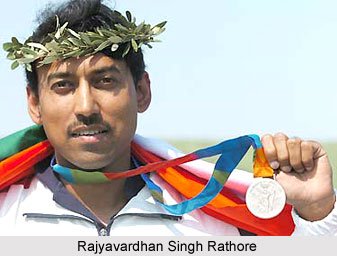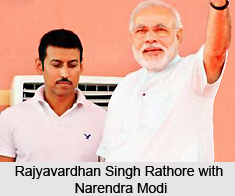 Rajyavardhan Singh Rathore is measured as the promising contemporary marksmen; and possesses the distinction of winning India`s first individual silver medal in the 2004 Summer Olympics in Shooting. Born in January 29, 1970 in Jaisalmer in Rajasthan, Atmore`s father is a Colonel in the Indian Army named Col. Laxman Singh Rathore and his mother Manju Rathore is a teacher.
Rajyavardhan Singh Rathore is measured as the promising contemporary marksmen; and possesses the distinction of winning India`s first individual silver medal in the 2004 Summer Olympics in Shooting. Born in January 29, 1970 in Jaisalmer in Rajasthan, Atmore`s father is a Colonel in the Indian Army named Col. Laxman Singh Rathore and his mother Manju Rathore is a teacher.
Early Life of Rajyavardhan Singh Rathore
Though famous as a shooter, the world`s third best double trap shooter was a very good cricketer in his childhood; getting selected into the Madhya Pradesh state team for the Ranji Trophy when he was merely 15. His mother, concerned about academics, discouraged. Eventually he was not selected for the team and he appeared in the National Defense Academy examination whereupon he qualified for the army.
Rathore distinguished himself in the military as well. While still a Major, he received the `Sword of Honour` from Indian Military Academy in 1990. He fought bravely against the separatist militants in Indian-administered Kashmir in Kargil War in the year of 1999. He took up shooting seriously in 1998, a year before the war. He got married to an army doctor, Dr. Gayatri in the same year. At present he is a Lt. Colonel in the Indian Army.
Career of Rajyavardhan Singh Rathore
Rajyavardhan Singh Rathore got the chance to compete in the 2004 Olympics Men`s Double Trap after he won a bronze medal at the World Championship in Cyprus. He received training in Europe from the Atlanta Olympic gold medallist Russel Mark of Australia. He was the member of the winning team in the double trap event in the Commonwealth Shooting Championships, 2005 held in Melbourne. He also won the gold in the individual and team events in Men`s double trap at the 2005 Asian Clay shooting championships at Bangkok. With the gold in the individual event, he completed a hat trick at the annual events, as he was the champion in 2003 and 2004 as well.
 Political Career of Rajyavardhan Singh Rathore
Political Career of Rajyavardhan Singh Rathore
It was on 10 September 2013 when Rajyavardhan Singh Rathore joined Bharatiya Janata Party (BJP) after taking voluntary retirement from the Indian Army. After that, Rajyavardhan Singh Rathore was elected as a Member of Parliament in the 2014 Lok Sabha election from Jaipur Rural Election. On 9 November 2014, he was sworn as the Minister of State for Information & Broadcasting in the Cabinet Ministry of Narendra Modi.
Achievements of Rajyavardhan Singh Rathore
The Government of India awarded him the `Rajiv Gandhi Khel Ratna Award`, the highest sporting honour of India in 2004-2005 for his performance in the `Olympic Games`. He won the `Ati Vishisht Seva Medal` (AVSM), an award for exceptional service, presented by the government. By winning this award, he became the first officer from the Indian Army below the rank of Brigadier to be awarded the AVSM. He was also honoured with the `Arjuna Award` in 2003-2004. He is a recipient of the `Padma Shri`, a very honorary civilian award from the Government of India. Rajyavardhan Singh Rathore has been the poster boy of Indian shooting ever since he won the first individual Olympic silver medal for India in the 2004 Athens Games.
Rajyavardhan Rathore has escalated such an event that tests both skill and reflexes. Though there were a lot of expectations from the Indian sports enthusiasts for his success, Rajyavardhan Singh Rathore failed to win a medal in the Beijing Olympics, 2008.




















